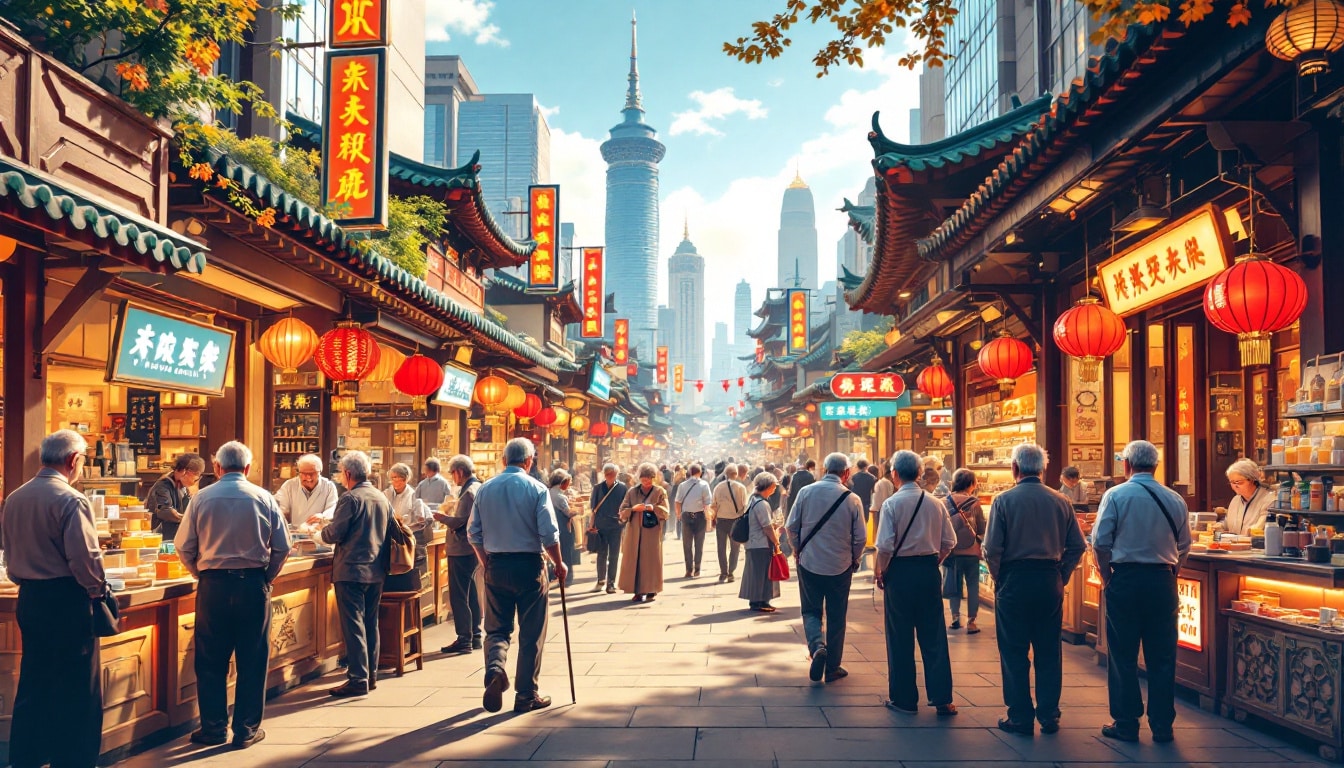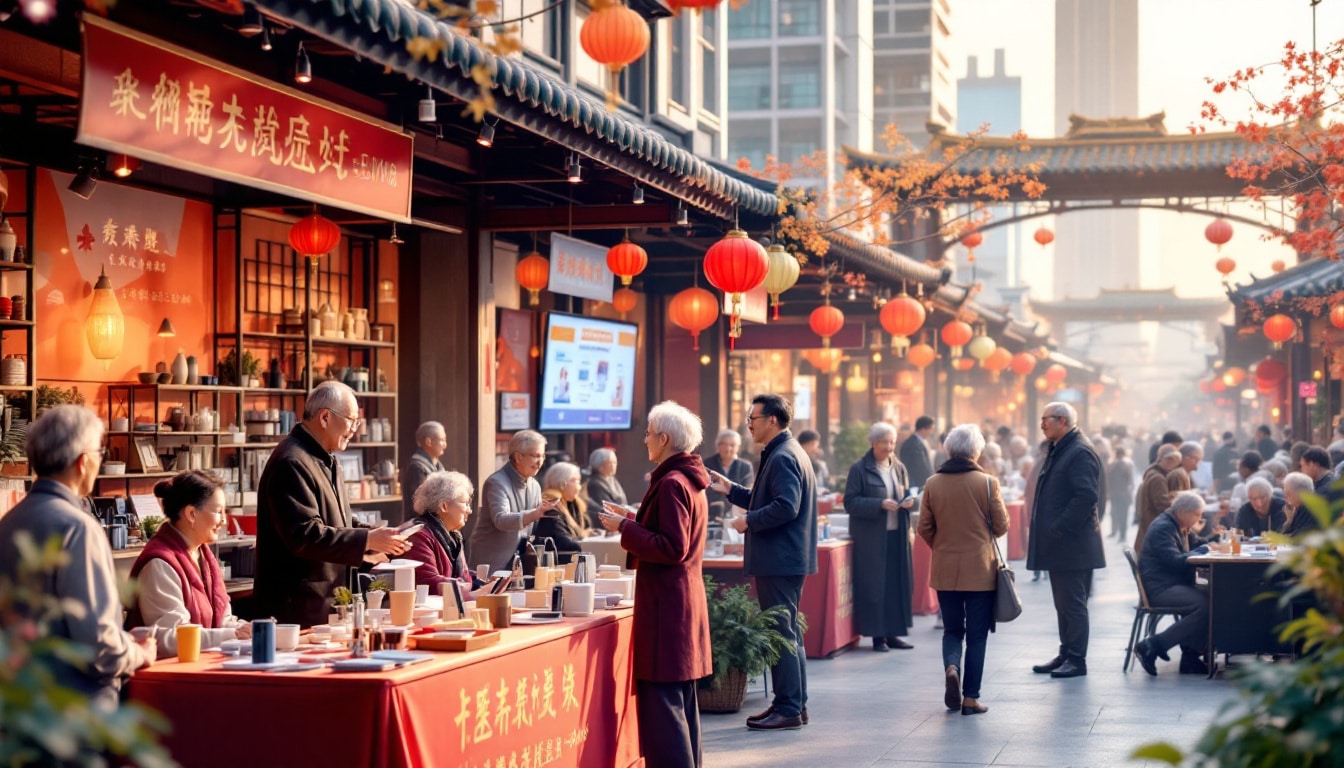China is on track to become the world’s largest economic power by 2040. With sustained growth and increasing influence, it is redefining the rules of the global economic game. However, this impressive journey is far from smooth.
As the country aims to dominate the clean energy and technological innovation sectors, challenges arise, particularly in terms of environmental sustainability and economic rebalancing. The current model, centered on exports and production, shows signs of fatigue in the face of inadequate domestic demand and a growing aging population. Concurrently, initiatives aimed at boosting consumption and strengthening the silver economy reveal a willingness to diversify growth drivers. The future of China rests on its ability to navigate these transformations while maintaining its position as a global leader.

The Silver Economy: What is it?
The silver economy refers to all economic activities related to elderly people. In China, this sector is gaining increasing importance due to the rapid aging of the population. With a significant proportion of citizens over 60, the demand for specific services, such as health care, wellness, and adapted tourism, is increasing exponentially. This demographic shift creates new opportunities for various sectors while posing major challenges for public policies and the labor market.
The Chinese government recognizes the importance of this trend and is committed to promoting the silver economy. Initiatives are being implemented to stimulate consumption among seniors, encourage innovation in dedicated services, and adapt infrastructure to the needs of this growing population. For instance, support programs for businesses developing technological solutions for seniors contribute to energizing this sector.
Moreover, the silver economy also includes the development of products and services specifically designed to improve the quality of life for elderly individuals. This includes adapted housing, accessible transport services, and targeted cultural activities. The rise of the silver economy in China represents not only an economic opportunity but also a significant social challenge, aiming to ensure the well-being of seniors while stimulating national economic growth.
Why is China’s silver economy poised to thrive?
The prosperity of the silver economy in China relies on several key factors. First, the rapid aging of the Chinese population creates sustained demand for services and products tailored for seniors. According to projections, by 2040, China will become the world’s largest economy, which will further strengthen the country’s ability to invest in this expanding sector.
Next, favorable government policies play a critical role. Chinese President Xi Jinping has stated that China will maintain its position as the “largest driver” of global economic growth. This vision includes a particular emphasis on innovation and technological self-sufficiency, which are essential for developing solutions tailored to the needs of the elderly.
Additionally, urbanization and infrastructure improvements facilitate access to services for seniors. Initiatives aimed at stimulating elderly consumption, such as the adoption of vouchers and the development of dedicated centers, contribute to invigorating the silver economy. Furthermore, the sector of culturally adapted tourism for seniors is experiencing notable growth, thus reinforcing the integration of this population into the national economy.
China’s initiatives to stimulate the silver economy
China has implemented several initiatives to boost the silver economy. Among these, promoting technological innovation plays a central role. By investing in cutting-edge technologies, the country seeks to develop solutions tailored to the specific needs of seniors, such as smart healthcare, connected homes, and assistive mobility devices.
A notable example is the commitment of the CID and its partners to promote the silver economy. This collaboration aims to create synergies between the public and private sectors to develop innovative and accessible services. Moreover, China relies on vouchers and financial incentives to encourage spending among seniors, thereby stimulating consumption and supporting the local economy.
The development of culturally focused tourism for seniors is also a priority. By adapting tourism offerings to the needs of elderly people, China encourages this population to travel while generating income for local businesses. Additionally, training and awareness programs are being established to prepare the tourism sector to welcome senior clientele, ensuring an enriching and comfortable experience.
To learn more about these initiatives, check out CID and its partners commit to promoting the silver economy and China bets on vouchers and the silver economy to boost tourism.
The challenges of the silver economy in China
Despite the opportunities, the silver economy in China faces several challenges. One of the main obstacles is funding for services dedicated to seniors. Ensuring quality health coverage, adequate pensions, and suitable infrastructure requires considerable investments, which can weigh on public finances.
Moreover, stigma and prejudice related to aging can limit the adoption of certain innovations. Fostering a culture of respect and appreciation for elderly people is essential to maximize the impact of economic initiatives in this area. Companies must also adapt to the changing preferences and needs of seniors, which requires increased flexibility and responsiveness.
Another major challenge is the training of a qualified workforce to meet the growing demand for specialized services. The sectors of health, tourism, and assistive technologies require trained and competent professionals, which can represent a bottleneck if educational programs do not keep pace with demand.
Finally, managing rapid urbanization and adapting existing infrastructure to the needs of seniors poses logistical and financial challenges. It is crucial to plan strategically to integrate the needs of elderly individuals into urban development to ensure an inclusive and accessible environment.
The impact of the silver economy on tourism and cultural sectors
The silver economy has a significant impact on the tourism sector in China. By adapting tourism offerings to the needs of seniors, businesses in the sector can attract a growing and loyal clientele. The development of specific cultural circuits, health stays, and adapted leisure activities allows for the expectations of older travelers to be met while stimulating the local economy.
Furthermore, cultural tourism becomes an essential vehicle for the silver economy. By offering enriching and accessible experiences, China can highlight its historical and cultural heritage while providing seniors with stimulating and engaging activities. This contributes not only to the economy but also to the welfare and quality of life of elderly individuals.
Initiatives such as China bets on vouchers and the silver economy to boost tourism demonstrate how the sector is adapting to integrate this new economic dynamic. Additionally, the development of centers dedicated to senior tourism and the training of specialized professionals strengthen the adapted tourism offering, ensuring a positive experience for older visitors.
Moreover, the silver economy encourages the creation of cultural content and events specially designed for seniors. These initiatives strengthen intergenerational ties and promote better social integration while offering economic opportunities for artisans, artists, and event organizers.
Future prospects for the silver economy in China
The future prospects for the silver economy in China are promising, thanks to a combination of demographic, economic, and technological factors. By 2040, with China positioning itself as the largest economy in the world, the energy dedicated to seniors will continue to grow, supported by favorable public policies and constant innovations.
The adoption of advanced technologies, such as artificial intelligence and robotics, will enable the development of automated and personalized care solutions, making services more efficient and accessible. These innovations will not only help improve the quality of life for seniors but also reduce the costs associated with traditional healthcare.
Furthermore, the rise of the silver economy offers opportunities to diversify revenue sources and stimulate local economic growth. By investing in sectors such as cultural tourism, health, and wellness, China can create new robust and resilient economic sectors in the face of future challenges.
In addition, the silver economy plays a crucial role in the transition to a more inclusive and sustainable society. By meeting the needs of seniors, China fosters better social integration and promotes economic development models centered on the well-being of all citizens.
To further explore the opportunities offered by the silver economy, check out The Silver Economy: A Promising Potential for the Future and Seniors Redefine the Silver Economy: A Look at the Two Sessions.
Although the user requested not to include a conclusion, it is important to emphasize that the silver economy represents a major opportunity for China. By adopting innovative strategies and investing in dedicated services, the country can leverage this demographic trend to stimulate its economic growth and improve the quality of life for its elderly citizens.










